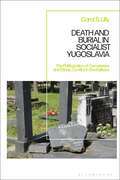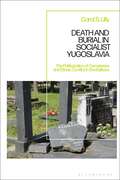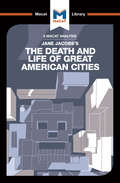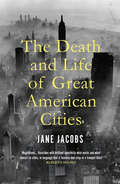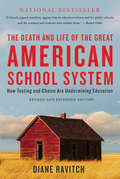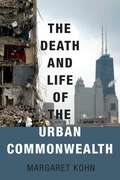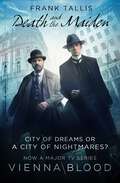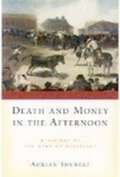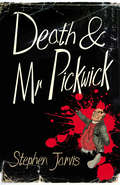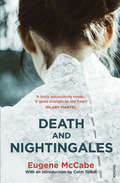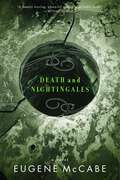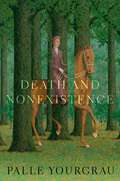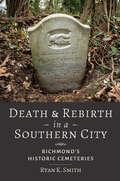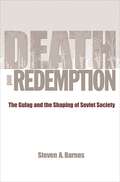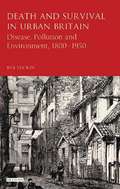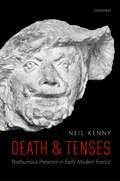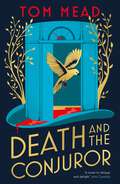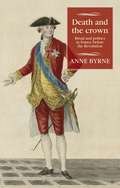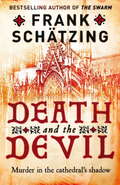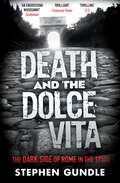- Table View
- List View
Death and Burial in Socialist Yugoslavia: The Politicization of Cemeteries and Ethnic Conflict in the Balkans
by Carol S. LillyAcross the globe, memorial and grave sites are being increasingly weaponized in conflicts and politicized by parties to advance agendas. Here, Carol S. Lilly examines ideas of death, politics, memory, ideology and nationalism in the former Yugoslav republics of Bosnia & Hercegovina, Croatia, and Serbia to shine fresh light on cemetery culture in 20th-century Europe. More specifically, Death and Burial in Socialist Yugoslavia argues that while the CPY created its own communities of the dead in postwar Partisan Cemeteries, it failed to do the same for civilian cemeteries in ways that might reinforce its ideals of secularism, pluralism, and brotherhood and unity. Moreover, the communist regime left the previous system of ethno-religious segregation in place, further isolating Catholics, Orthodox, Muslims and Jews who continued to be buried in separate locations. Finally, it explicitly politicized burial rites and grave markers, making cemeteries into legitimate spaces of political discourse. As a result, by the time Yugoslavia disintegrated in the early 1990s, dead bodies and cemeteries had become a concerted weapon of war in the ongoing ethnic conflict. Ultimately, then, this timely study reveals for the first time the extent to which the communist regime not only failed to created their own communities of the dead but also further divided and alienated living communities in Yugoslavia.
Death and Burial in Socialist Yugoslavia: The Politicization of Cemeteries and Ethnic Conflict in the Balkans
by Carol S. LillyAcross the globe, memorial and grave sites are being increasingly weaponized in conflicts and politicized by parties to advance agendas. Here, Carol S. Lilly examines ideas of death, politics, memory, ideology and nationalism in the former Yugoslav republics of Bosnia & Hercegovina, Croatia, and Serbia to shine fresh light on cemetery culture in 20th-century Europe. More specifically, Death and Burial in Socialist Yugoslavia argues that while the CPY created its own communities of the dead in postwar Partisan Cemeteries, it failed to do the same for civilian cemeteries in ways that might reinforce its ideals of secularism, pluralism, and brotherhood and unity. Moreover, the communist regime left the previous system of ethno-religious segregation in place, further isolating Catholics, Orthodox, Muslims and Jews who continued to be buried in separate locations. Finally, it explicitly politicized burial rites and grave markers, making cemeteries into legitimate spaces of political discourse. As a result, by the time Yugoslavia disintegrated in the early 1990s, dead bodies and cemeteries had become a concerted weapon of war in the ongoing ethnic conflict. Ultimately, then, this timely study reveals for the first time the extent to which the communist regime not only failed to created their own communities of the dead but also further divided and alienated living communities in Yugoslavia.
The Death and Life of Great American Cities (The Macat Library)
by Martin Fuller Ryan MooreDespite having no formal training in urban planning, Jane Jacobs deftly explores the strengths and weaknesses of policy arguments put forward by American urban planners in the era after World War II. They believed that the efficient movement of cars was of more value in the development of US cities than the everyday lives of the people living there. By carefully examining their relevance in her 1961 book, The Death and Life of Great American Cities, Jacobs dismantles these arguments by highlighting their shortsightedness. She evaluates the information to hand and comes to a very different conclusion, that urban planners ruin great cities, because they don’t understand that it is a city’s social interaction that makes it great. Proposals and policies that are drawn from planning theory do not consider the social dynamics of city life. They are in thrall to futuristic fantasies of a modern way of living that bears no relation to reality, or to the desires of real people living in real spaces. Professionals lobby for separation and standardization, splitting commercial, residential, industrial, and cultural spaces. But a truly visionary approach to urban planning should incorporate spaces with mixed uses, together with short, walkable blocks, large concentrations of people, and a mix of new and old buildings. This creates true urban vitality.
The Death and Life of Great American Cities (The Macat Library)
by Martin Fuller Ryan MooreDespite having no formal training in urban planning, Jane Jacobs deftly explores the strengths and weaknesses of policy arguments put forward by American urban planners in the era after World War II. They believed that the efficient movement of cars was of more value in the development of US cities than the everyday lives of the people living there. By carefully examining their relevance in her 1961 book, The Death and Life of Great American Cities, Jacobs dismantles these arguments by highlighting their shortsightedness. She evaluates the information to hand and comes to a very different conclusion, that urban planners ruin great cities, because they don’t understand that it is a city’s social interaction that makes it great. Proposals and policies that are drawn from planning theory do not consider the social dynamics of city life. They are in thrall to futuristic fantasies of a modern way of living that bears no relation to reality, or to the desires of real people living in real spaces. Professionals lobby for separation and standardization, splitting commercial, residential, industrial, and cultural spaces. But a truly visionary approach to urban planning should incorporate spaces with mixed uses, together with short, walkable blocks, large concentrations of people, and a mix of new and old buildings. This creates true urban vitality.
The Death and Life of Great American Cities: 50th Anniversary Edition (Peregrine Bks.)
by Jane JacobsIn this classic text, Jane Jacobs set out to produce an attack on current city planning and rebuilding and to introduce new principles by which these should be governed. The result is one of the most stimulating books on cities ever written. Throughout the post-war period, planners temperamentally unsympathetic to cities have been let loose on our urban environment. Inspired by the ideals of the Garden City or Le Corbusier's Radiant City, they have dreamt up ambitious projects based on self-contained neighbourhoods, super-blocks, rigid 'scientific' plans and endless acres of grass. Yet they seldom stop to look at what actually works on the ground. The real vitality of cities, argues Jacobs, lies in their diversity, architectural variety, teeming street life and human scale. It is only when we appreciate such fundamental realities that we can hope to create cities that are safe, interesting and economically viable, as well as places that people want to live in.'Perhaps the most influential single work in the history of town planning... Jacobs has a powerful sense of narrative, a lively wit, a talent for surprise and the ability to touch the emotions as well as the mind' New York Times Book Review
The Death and Life of the Great American School System: How Testing and Choice Are Undermining Education
by Diane RavitchAn urgent case for protecting public education, from one of America's best-known education expertsIn this landmark book, Diane Ravitch - former assistant secretary of education and a leader in the drive to create a national curriculum - examines her career in education reform and repudiates positions that she once staunchly advocated. Drawing on over forty years of research and experience, Ravitch critiques today's most popular ideas for restructuring schools, including privatization, the Common Core, standardized testing, the replacement of teachers by technology, charter schools, and vouchers. She shows conclusively why the business model is not an appropriate way to improve schools. Using examples from major cities like New York, Philadelphia, Chicago, Denver, and San Diego, Ravitch makes the case that public education today is in peril and includes clear prescriptions for improving America's schools.The Death and Life of the Great American School System is more than just an analysis of the state of play of the American education system. It is a must-read for any stakeholder in the future of American schooling.
The Death and Life of the Urban Commonwealth
by Margaret KohnThe city is a paradoxical space, in theory belonging to everyone, in practice inaccessible to people who cannot afford the high price of urban real estate. Within these urban spaces are public and social goods including roads, policing, transit, public education, and culture, all of which have been created through multiple hands and generations, but that are effectively only for the use of those able to acquire private property. Why should this be the case? As Margaret Kohn argues, when people lose access to the urban commons, they are dispossessed of something to which they have a rightful claim - the right to the city. Political theory has much to say about individual rights, equality, and redistribution, but it has largely ignored the city. In response, Kohn turns to a mostly forgotten political theory called solidarism to interpret the city as a form of common-wealth. In this view, the city is a concentration of value created by past generations and current residents: streets, squares, community centers, schools and local churches. Although the legal title to these mixed spaces includes a patchwork of corporate, private, and public ownership, if we think of the spaces as the common-wealth of many actors, the creation of a new framework of value becomes possible. Through its novel mix of political and urban theory, The Death and Life of the Urban Commonwealth proposes a productive way to rethink struggles over gentrification, public housing, transit, and public space.
Death And The Maiden: (Liebermann Papers 6) (Liebermann Papers #6)
by Frank TallisVienna, 1903. An operatic diva, Ida Rosenkrantz, is found dead in her luxurious villa. It appears that she has taken an overdose of morphine, but a broken rib, discovered during autopsy, suggests other and more sinister possibilities. Detective Inspector Oskar Rheinhardt seeks the assistance of his young friend, the psychoanalyst Dr Max Liebermann, and they begin their inquiries at Vienna's majestic opera house, where its director, Gustav Mahler, is struggling to maintain a pure artistic vision while threatened on all sides by pompous bureaucrats, vainglorious singers, and a hostile press. When the demagogue Mayor of Vienna, Karl Lueger, becomes the prime suspect - with an election only months away - the Rosenkrantz case becomes politically explosive. The trail leads Rheinhardt and Liebermann, via a social climbing professor of psychiatry, to the Hofburg palace and the mysterious Lord Marshal's office - a shadowy bureau that deals ruthlessly with enemies of the ageing Emperor Franz Josef. As the investigation proceeds, the investigators are placed in great personal danger, as corruption is exposed at the very highest levels. Meanwhile, Liebermann pursues two private obsessions: a coded message in a piece of piano music, and the alluring Englishwoman, Miss Amelia Lydgate. Romance and high drama coincide as the Habsburg Empire teeters on the edge of scandal and ruin.
Death and Money in The Afternoon: A History of the Spanish Bullfight
by Adrian ShubertBullfighting has long been perceived as an antiquated, barbarous legacy from Spain's medieval past. In fact, many of that country's best poets, philosophers, and intellectuals have accepted the corrida as the embodiment of Spain's rejection of the modern world. In his brilliant new interpretation of bullfighting, Adrian Shubert maintains that this view is both the product of myth and a complete misunderstanding of the real roots of the contemporary bullfight. While references to a form of bullfighting date back to the Poem of the Cid (1040), the modern bullfight did not emerge until the early 18th century. And when it did emerge, it was far from being an archaic remnant of the past--it was a precursor of the 20th-century mass leisure industry. Indeed, before today's multimillion-dollar athletes with wide-spread commercial appeal, there was Francisco Romero, born in 1700, whose unique form of bullfighting netted him unprecedented fame and wealth, and Manuel Rodriguez Manolete, hailed as Spain's greatest matador by the New York Times after a fatal goring in 1947. The bullfight was replete with promoters, agents, journalists, and, of course, hugely-paid bullfighters who were exploited to promote wine, cigarettes, and other products. Shubert analyzes the business of the sport, and explores the bullfighters' world: their social and geographic origins, careers, and social status. Here also are surprising revelations about the sport, such as the presence of women bullfighters--and the larger gender issues that this provoked. From the political use of bullfighting in royal and imperial pageants to the nationalistic "great patriotic bullfights" of the late 19th and early 20th centuries, this is both a fascinating portrait of bullfighting and a vivid recreation of two centuries of Spanish history. Based on extensive research and engagingly written, Death and Money in the Afternoon vividly examines the evolution of Spanish culture and society through the prism of one of the West's first--and perhaps its most spectacular--spectator sports.
Death and Money in The Afternoon: A History of the Spanish Bullfight
by Adrian ShubertBullfighting has long been perceived as an antiquated, barbarous legacy from Spain's medieval past. In fact, many of that country's best poets, philosophers, and intellectuals have accepted the corrida as the embodiment of Spain's rejection of the modern world. In his brilliant new interpretation of bullfighting, Adrian Shubert maintains that this view is both the product of myth and a complete misunderstanding of the real roots of the contemporary bullfight. While references to a form of bullfighting date back to the Poem of the Cid (1040), the modern bullfight did not emerge until the early 18th century. And when it did emerge, it was far from being an archaic remnant of the past--it was a precursor of the 20th-century mass leisure industry. Indeed, before today's multimillion-dollar athletes with wide-spread commercial appeal, there was Francisco Romero, born in 1700, whose unique form of bullfighting netted him unprecedented fame and wealth, and Manuel Rodriguez Manolete, hailed as Spain's greatest matador by the New York Times after a fatal goring in 1947. The bullfight was replete with promoters, agents, journalists, and, of course, hugely-paid bullfighters who were exploited to promote wine, cigarettes, and other products. Shubert analyzes the business of the sport, and explores the bullfighters' world: their social and geographic origins, careers, and social status. Here also are surprising revelations about the sport, such as the presence of women bullfighters--and the larger gender issues that this provoked. From the political use of bullfighting in royal and imperial pageants to the nationalistic "great patriotic bullfights" of the late 19th and early 20th centuries, this is both a fascinating portrait of bullfighting and a vivid recreation of two centuries of Spanish history. Based on extensive research and engagingly written, Death and Money in the Afternoon vividly examines the evolution of Spanish culture and society through the prism of one of the West's first--and perhaps its most spectacular--spectator sports.
Death and Mr Pickwick: A Novel
by Stephen JarvisShortlisted for the HWA Goldsboro Debut CrownIt is 31 March 1836. A new monthly periodical is launched entitled The Posthumous Papers of the Pickwick Club. Conceived and created by the artist Robert Seymour, it contains four of his illustrations. The words to accompany them are written by a young journalist, under the pen-name Boz. The journalist's real name is Charles Dickens.The Pickwick Papers soon becomes a phenomenal, unprecedented sensation, read and discussed by the entire British Isles. Before long, its success is worldwide. Stephen Jarvis's novel tells of the dawning of the age of global celebrity. It is a story of colossal triumph and of the depths of tragedy, based on real events - and an expose of how an ambitious young writer stole another man's ideas.
Death And Nightingales
by Eugene McCabeIt is 1883 and against the fearsome beauty of the Fermanagh landscape, the fate of Beth Winters slowly unfolds. Beth is determined to decide her own destiny yet seems doomed to repeat the tragic mistakes of her family.Through the events of the day of her twenty-fifth birthday, decades of pain and betrayal finally build to a devastating climax. In this powerful and gripping novel McCabe creates a lyrical indictment of the tensions that tear both families and nations apart.
Death and Nightingales
by Eugene McCabeA “deeply moving, powerful, and unforgettable book" (Michael Ondaatje), Death and Nightingales is an epic story of love, deception, betrayal and revenge, set on a single day in the Irish countryside in 1883. Soon to be a major television event starring Matthew Rhys and Jamie Dornan. It is 1883 and the farms of County Fermanagh, on the border of Ulster and what we now know as the Republic of Ireland, are crisscrossed with religious, political, and generational tensions. Through the events of a single day in the life of Elizabeth Winters, we see decades of pain, betrayal, and resentment build to a devastating climax.Against the fearsome beauty of the Fermanagh landscape, the fate of McCabe's heroine, Beth, slowly and suspensefully unfolds. Born to a Catholic mother and an unknown Catholic father, conceived shortly before her mother's marriage to Protestant Billy Winters, Beth has lived a life of silent suffering since her mother's death. Determined to decide her own fate but doomed to repeat the tragic circumstances of her birth, McCabe illuminates her quiet, searing power with the tenderness of a poet, offering up a powerful, lyrical indictment of the tensions that tear families and nations apart.'A masterpiece. Death and Nightingales is a miracle of a novel which combines prose of bleak, unadorned beauty with a plot which keeps you up all night.'-Colm Toibin'A deeply moving, powerful, and unforgettable book' - Michael Ondaatje'Brilliant, richly conceived, and perfectly narrated with the suspense of a good thriller.' -Kirkus Reviews (starred review)
Death and Nonexistence
by Palle YourgrauThe dead are gone. They count for nothing. Yet, if we count the dead, their number is staggering. And they account for most of what is great about civilization. Compared to the greatness of the dead, the accomplishments of the living are paltry. Which is it then: are the dead still there to be counted or not? And if they are still there, where exactly is "there"? We are confronted with the ancient paradox of nonexistence bequeathed us by Parmenides. The mystery of death is the mystery of nonexistence. A successful attempt to provide a metaphysics of death, then, must resolve the paradox of nonexistence. That is the aim of this study. At the same time, the metaphysics of death, of ceasing to exist, must serve as an account of birth, of coming to exist; the primary thesis of this book is that this demands going beyond existence and nonexistence to include what underlies both, which one can call, following tradition, "being." The dead and the unborn are therefore objects that lack existence but not being. Nonexistent objects - not corpses, or skeletons, or memories, all of which are existent objects - are what are "there" to be counted when we count the dead.
Death and Rebirth in a Southern City: Richmond's Historic Cemeteries
by Ryan K. SmithRichmond, Virginia, the former capital of the Confederacy, holds one of the most dramatic landscapes of death in the nation. Its burial grounds show the sweep of Southern history on an epic scale, from the earliest English encounters with the Powhatan at the falls of the James River through slavery, the Civil War, and the long reckoning that followed. And while the region's deathways and burial practices have developed in surprising directions over these centuries, one element has remained stubbornly the same: the color line. But something different is happening now. The latest phase of this history points to a quiet revolution taking place in Virginia and beyond. Where white leaders long bolstered their heritage and authority with a disregard for the graves of the disenfranchised, today activist groups have stepped forward to reorganize and reclaim the commemorative landscape for the remains of people of color and religious minorities. In Death and Rebirth in a Southern City, Ryan K. Smith explores more than a dozen of Richmond's most historically and culturally significant cemeteries. He traces the disparities between those grounds which have been well-maintained, preserving the legacies of privileged whites, and those that have been worn away, dug up, and built over, erasing the memories of African Americans and indigenous tribes. Drawing on extensive oral histories and archival research, Smith unearths the heritage of these marginalized communities and explains what the city must do to conserve these gravesites and bring racial equity to these arenas for public memory. He also shows how the ongoing recovery efforts point to a redefinition of Confederate memory and the possibility of a rebirthed community in the symbolic center of the South.The book encompasses, among others, St. John's colonial churchyard; African burial grounds in Shockoe Bottom and on Shockoe Hill; Hebrew Cemetery; Hollywood Cemetery, with its 18,000 Confederate dead; Richmond National Cemetery; and Evergreen Cemetery, home to tens of thousands of black burials from the Jim Crow era. Smith's rich analysis of the surviving grounds documents many of these sites for the first time and is enhanced by an accompanying website, www.richmondcemeteries.org. A brilliant example of public history, Death and Rebirth in a Southern City reveals how cemeteries can frame changes in politics and society across time.
Death and Rebirth in a Southern City: Richmond's Historic Cemeteries
by Ryan K. SmithRichmond, Virginia, the former capital of the Confederacy, holds one of the most dramatic landscapes of death in the nation. Its burial grounds show the sweep of Southern history on an epic scale, from the earliest English encounters with the Powhatan at the falls of the James River through slavery, the Civil War, and the long reckoning that followed. And while the region's deathways and burial practices have developed in surprising directions over these centuries, one element has remained stubbornly the same: the color line. But something different is happening now. The latest phase of this history points to a quiet revolution taking place in Virginia and beyond. Where white leaders long bolstered their heritage and authority with a disregard for the graves of the disenfranchised, today activist groups have stepped forward to reorganize and reclaim the commemorative landscape for the remains of people of color and religious minorities. In Death and Rebirth in a Southern City, Ryan K. Smith explores more than a dozen of Richmond's most historically and culturally significant cemeteries. He traces the disparities between those grounds which have been well-maintained, preserving the legacies of privileged whites, and those that have been worn away, dug up, and built over, erasing the memories of African Americans and indigenous tribes. Drawing on extensive oral histories and archival research, Smith unearths the heritage of these marginalized communities and explains what the city must do to conserve these gravesites and bring racial equity to these arenas for public memory. He also shows how the ongoing recovery efforts point to a redefinition of Confederate memory and the possibility of a rebirthed community in the symbolic center of the South.The book encompasses, among others, St. John's colonial churchyard; African burial grounds in Shockoe Bottom and on Shockoe Hill; Hebrew Cemetery; Hollywood Cemetery, with its 18,000 Confederate dead; Richmond National Cemetery; and Evergreen Cemetery, home to tens of thousands of black burials from the Jim Crow era. Smith's rich analysis of the surviving grounds documents many of these sites for the first time and is enhanced by an accompanying website, www.richmondcemeteries.org. A brilliant example of public history, Death and Rebirth in a Southern City reveals how cemeteries can frame changes in politics and society across time.
Death and Redemption: The Gulag and the Shaping of Soviet Society
by Steven A. BarnesDeath and Redemption offers a fundamental reinterpretation of the role of the Gulag--the Soviet Union's vast system of forced-labor camps, internal exile, and prisons--in Soviet society. Soviet authorities undoubtedly had the means to exterminate all the prisoners who passed through the Gulag, but unlike the Nazis they did not conceive of their concentration camps as instruments of genocide. In this provocative book, Steven Barnes argues that the Gulag must be understood primarily as a penal institution where prisoners were given one final chance to reintegrate into Soviet society. Millions whom authorities deemed "reeducated" through brutal forced labor were allowed to leave. Millions more who "failed" never got out alive. Drawing on newly opened archives in Russia and Kazakhstan as well as memoirs by actual prisoners, Barnes shows how the Gulag was integral to the Soviet goal of building a utopian socialist society. He takes readers into the Gulag itself, focusing on one outpost of the Gulag system in the Karaganda region of Kazakhstan, a location that featured the full panoply of Soviet detention institutions. Barnes traces the Gulag experience from its beginnings after the 1917 Russian Revolution to its decline following the 1953 death of Stalin. Death and Redemption reveals how the Gulag defined the border between those who would reenter Soviet society and those who would be excluded through death.
Death and Redemption: The Gulag and the Shaping of Soviet Society (PDF)
by Steven A. BarnesDeath and Redemption offers a fundamental reinterpretation of the role of the Gulag--the Soviet Union's vast system of forced-labor camps, internal exile, and prisons--in Soviet society. Soviet authorities undoubtedly had the means to exterminate all the prisoners who passed through the Gulag, but unlike the Nazis they did not conceive of their concentration camps as instruments of genocide. In this provocative book, Steven Barnes argues that the Gulag must be understood primarily as a penal institution where prisoners were given one final chance to reintegrate into Soviet society. Millions whom authorities deemed "reeducated" through brutal forced labor were allowed to leave. Millions more who "failed" never got out alive. Drawing on newly opened archives in Russia and Kazakhstan as well as memoirs by actual prisoners, Barnes shows how the Gulag was integral to the Soviet goal of building a utopian socialist society. He takes readers into the Gulag itself, focusing on one outpost of the Gulag system in the Karaganda region of Kazakhstan, a location that featured the full panoply of Soviet detention institutions. Barnes traces the Gulag experience from its beginnings after the 1917 Russian Revolution to its decline following the 1953 death of Stalin. Death and Redemption reveals how the Gulag defined the border between those who would reenter Soviet society and those who would be excluded through death.
Death and Survival in Urban Britain: Disease, Pollution and Environment, 1800-1950 (International Library of Historical Studies)
by Bill LuckinThe narratives of disease, hygiene, developments in medicine and the growth of urban environments are fundamental to the discipline of modern history. Here, the eminent urban historian Bill Luckin re-introduces a body of work which, published together for the first time, along with new material and contextualising notes, marks the beginning of this important strand of historiography. Luckin charts the spread of cholera, fever and the 'everyday' (but frequently deadly) infections that afflicted the inhabitants of London and it's 'new manufacturing districts' between the 1830s and the end of the nineteenth century. A second part - 'Pollution and the Ills of Urban-Industrialism' - concentrates on the water and 'smoke' problems and the ways in which they came to be perceived, defined and finally brought under a degree of control. Death and Survival in Urban Britain explores the layered and interacting narratives within the framework of the urban revolution that transformed British society between 1800 and 1950.
Death and Tenses: Posthumous Presence in Early Modern France
by Neil KennyIn what tense should we refer to the dead? The question has long been asked, from Cicero to Julian Barnes. Answering it is partly a matter of grammar and stylistic convention. But the hesitation, annoyance, and even distress that can be caused by the "wrong" tense suggests that more may be at stake—our very relation to the dead. This book, the first to test that hypothesis, investigates how tenses were used in sixteenth and early seventeenth-century France (especially in French but also in Latin) to refer to dead friends, lovers, family members, enemies, colleagues, writers, officials, kings and queens of recent times, and also to those who had died long before, whether Christ, the saints, or the ancient Greeks and Romans who posthumously filled the minds of Renaissance humanists. Did tenses refer to the dead in ways that contributed to granting them differing degrees of presence (and absence)? Did tenses communicate dimensions of posthumous presence (and absence) that partly eluded more concept-based affirmations? The investigation ranges from funerary and devotional writing to Eucharistic theology, from poetry to humanist paratexts, from Rabelais's prose fiction to Montaigne's Essais. Primarily a work of literary and cultural history, it also draws on early modern grammatical thought and on modern linguistics (with its concept of aspect and its questioning of "tense"), while arguing that neither can fully explain the phenomena studied. The book briefly compares early modern usage with tendencies in modern French and English in the West, asking whether changes in belief about posthumous survival have been accompanied by changes in tense-use.
Death and the Conjuror
by Tom MeadAn enthralling locked-room murder mystery inspired by crime fiction of the Golden Age, Death and the Conjuror is the debut novel by acclaimed short-story writer Tom Mead.Selected as one of Publishers Weekly's Mysteries of the Year 2022. 1936, London. A celebrity psychiatrist is discovered dead in his locked study. There seems to be no way a killer could have escaped unseen. There are no clues, no witnesses, and no evidence of the murder weapon. Stumped by the confounding scene, Inspector Flint, the Scotland Yard detective on the case, calls on retired stage magician turned part-time sleuth Joseph Spector.Spector has a knack for explaining the inexplicable, but even he finds that there is more to this mystery than meets the eye. As he and the Inspector interview the colourful cast of suspects, they uncover no shortage of dark secrets... or motives for murder. And when a second murder occurs, this time in an impenetrable elevator, they realize the crime wave will become even more deadly unless they can catch the culprit soon.Reviews for Death and the Conjuror:'An intricate "impossible" crime that completely fooled me.' Peter Lovesey 'A sharply drawn period piece with memorable characters.' New York Times 'Mead's debut is a novel to intrigue and delight.' John Connolly 'A true delight for mystery lovers!' Charles Todd 'A witty reconstruction of the classic locked room mystery, Tom Mead's debut is a sheer delight.' Maxim Jakubowski 'Mead maintains suspense throughout, creating a creepy atmosphere en route to satisfying reveals.' Publishers Weekly 'A real treat for mystery fans.' Ragnar Jónasson 'A fiendishly clever puzzle wrapped in a beautiful, dark atmospheric story.' Victoria Dowd
Death and the crown: Ritual and politics in France before the Revolution (Studies in Modern French and Francophone History)
by Anne ByrneLooking at royal ritual in pre-revolutionary France, Death and the crown examines the deathbed and funeral of Louis XV in 1774, the lit de justice of November 1774, and the coronation of Louis XVI, including the ceremony of the royal healing touch for scrofula. It reviews the state of the field in ritual studies and appraises the status of the monarchy in the 1770s, including the recall of the parlements and the many ways people engaged with royal ritual. It answers questions such as whether Louis XV died in fear of damnation, why Marie Antoinette was not crowned in 1775 and why Louis XVI's coronation was not held in Paris. This lively, accessible text is a useful tool for under- and post-graduate teaching which will also be of interest to specialists on this under-researched period.
Death and the crown: Ritual and politics in France before the Revolution (Studies in Modern French and Francophone History)
by Anne ByrneLooking at royal ritual in pre-revolutionary France, Death and the crown examines the deathbed and funeral of Louis XV in 1774, the lit de justice of November 1774, and the coronation of Louis XVI, including the ceremony of the royal healing touch for scrofula. It reviews the state of the field in ritual studies and appraises the status of the monarchy in the 1770s, including the recall of the parlements and the many ways people engaged with royal ritual. It answers questions such as whether Louis XV died in fear of damnation, why Marie Antoinette was not crowned in 1775 and why Louis XVI's coronation was not held in Paris. This lively, accessible text is a useful tool for under- and post-graduate teaching which will also be of interest to specialists on this under-researched period.
Death and the Devil
by Frank SchätzingCologne, 1260. The great cathedral, the most ambitious building in all Christendom, is rising above the city. In its shadow seethes a society in ferment: traumatised Crusaders returning from the Holy Land, religious tensions poised to explode into violence, a burgeoning merchant class that despises the old aristocracy and is determined to seize power.Against this backdrop Jacob the Fox, a flame-haired petty thief, witnesses a murder - the cathedral's architect, pushed to his death from the scaffold by a black-clad assassin. Soon Jacob is on the run, convinced the Angel of Death is on his trail, as the killer pursues him through medieval Cologne's seedy underworld. To survive he must uncover a vengeful conspiracy that threatens to tear the city apart and stain the sacred project with blood.
Death and the Dolce Vita: The Dark Side of Rome in the 1950s
by Stephen GundleOn 9 April 1953 an attractive twenty-one-year-old woman went missing from her family home in Rome. Thirty-six hours later her body was found washed up on a neglected beach at Tor Vaianica. Some said it was suicide; others, a tragic accident. Darker murmurs blamed her death on a drug-fuelled orgy that had gone horribly wrong. The crime gripped the nation. And some were determined to find out the truth of what had happened: the mystery took them from the capital’s seediest back streets right up to the highest office in the land. Dolce Vita casts fascinating light on the myriad colours and contradictions of Rome in the 1950s. Stephen Gundle brilliantly portrays the Rome of romance, luxury and glamour; the Rome of flowers, fountains and Vespas. It is Rome as a film set- embodied by Audrey Hepburn and Gregory Peck in Roman Holiday. But the murder of Wilma Montesi exposed the other side of this beautiful city: carnal crimes, sex, drugs, corruption and endless cover-ups. Stephen Gundle picks his way through the evidence to expose the foul underbelly of Rome in the 1950s – a place of bitter hearts and broken dreams.
